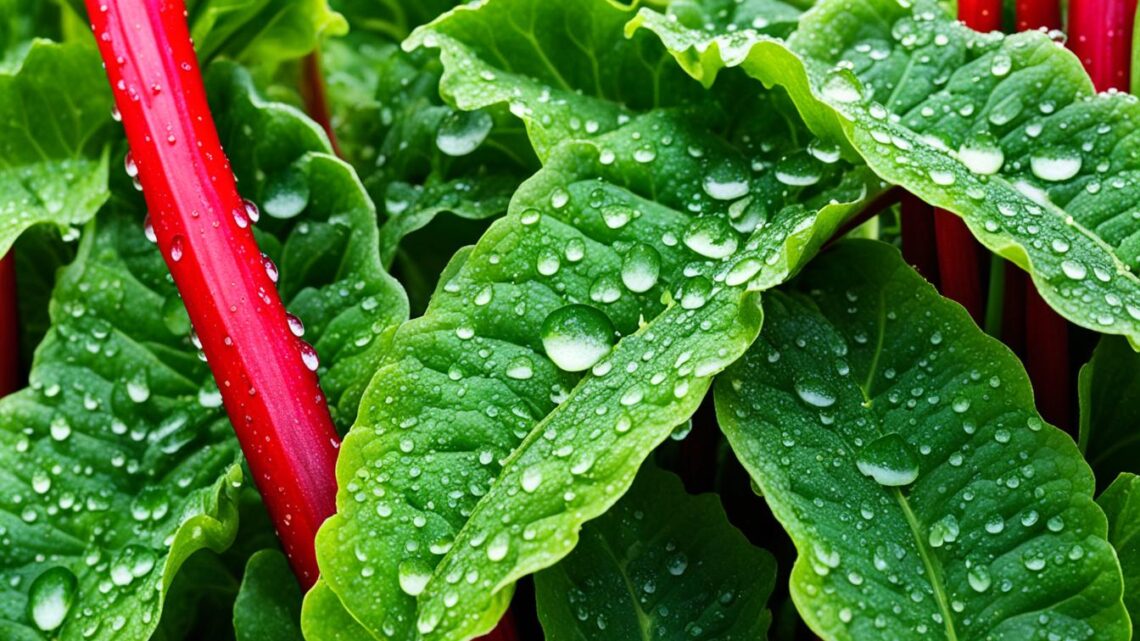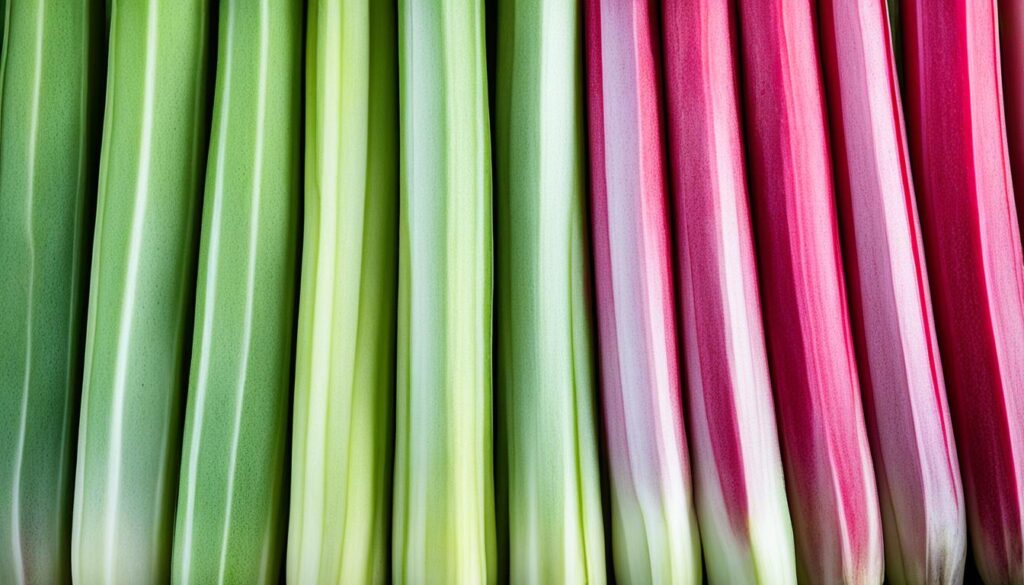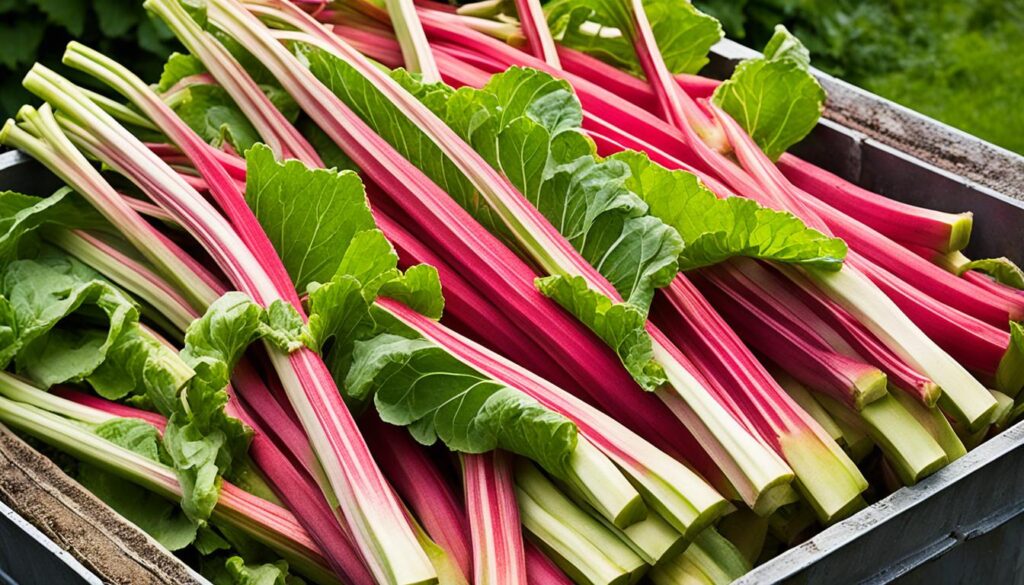
Have you ever thought about why people often call rhubarb a fruit, even though it’s really a vegetable? This guide will help you learn more about this special plant. It’s perfect for gardeners and cooks who love to try new things.
Rhubarb is known for its sour taste, which makes it great in pies, jams, and even cocktails. But it’s not just tasty; it’s also good for you. Let’s dive into the world of rhubarb and see how it can make your food better.
IN THIS ARTICLE
ToggleWhat is Rhubarb?
Rhubarb (Rheum rhabarbarum) is a plant that looks like a fruit but is really a vegetable. It belongs to the buckwheat family. The big, green leaves are toxic and should not be eaten. But, the stalks, or petioles, are safe to eat.
Botanical Classification and Edible Parts
Rhubarb stalks come in colors from bright red to mostly green. They are all safe to eat. They add a tart, tangy taste to dishes, especially sweet ones.
Nutritional Value and Toxicity
Rhubarb stalks are packed with vitamins C and K, and magnesium. They also have fiber and protein. But, the leaves have a lot of oxalic acid, which is toxic. Eating a lot of leaves can cause health problems.
It’s important to only eat the stalks and throw away the leaves. This way, you can enjoy rhubarb safely.
| Nutrient | Amount per 100g |
|---|---|
| Vitamin C | 8mg |
| Vitamin K | 26μg |
| Magnesium | 12mg |
| Fiber | 2g |
| Protein | 1g |

Growing Rhubarb
Planting and Caring for Rhubarb
Rhubarb is usually planted in early spring, when the ground can be worked. Put the crowns 1 inch below the soil, 3-4 feet apart. Rhubarb likes full sun but can handle some shade, especially in hot places. Make sure the soil drains well and add compost or rotted manure before planting.
Keep rhubarb moist during the growing season and mulch to keep the soil moist. Remove the flower stalks to help the plant focus on making tasty stalks. You can divide rhubarb plants every 4-5 years to keep them healthy.
Rhubarb Varieties
There are many rhubarb varieties known for their great taste and growth. ‘Canada Red’ and ‘Crimson Red’ have bright red stalks. ‘Victoria’ is a top choice with green stalks. ‘MacDonald’ and ‘Valentine’ are also great options.
Stalk color doesn’t affect the taste of rhubarb. But, green-stalked types might be more hardy and easier to grow in some areas.

Harvesting Rhubarb
Learning how to harvest rhubarb is key when you grow it. Timing and technique are very important. Here are some tips to help you get a great rhubarb harvest:
First, be patient. Don’t pick rhubarb in the first year after planting. It needs time to grow strong. In the second year, you can pick a few stalks. But wait until the third year for a full harvest, usually in spring and early summer.
When it’s time to pick, look for stalks that are 12-18 inches long and at least 3/4 inch thick. To pick, hold the stalk near the base and twist and pull it off. Avoid cutting the stalks, as this can spread disease. Make sure to leave at least 2 stalks per plant to help it keep producing.
It’s important to pick rhubarb at the right time. As summer gets hotter, the stalks get tougher. Stop picking by mid-summer to let the plant rest for next year.
| Rhubarb Harvest Tips |
|---|
|
By following these tips, you’ll get a lot of tasty rhubarb. It will make your meals special for years.

Preserving Rhubarb
Freezing Rhubarb
Rhubarb freezes well, letting you enjoy its tart taste all year. To freeze rhubarb, cut off the leaves and chop the stalks into 1-inch pieces. Put the pieces on a baking sheet in one layer and freeze until they’re solid. Then, move them to an airtight container or freezer bag.
You can also put the raw rhubarb pieces straight into the container, getting out as much air as you can. Frozen rhubarb stays good for up to 12 months. When you’re ready to use it, just add it to your recipes without thawing.
To get the best results when how to freeze rhubarb, follow these tips:
- Wash and trim the rhubarb stalks before cutting into 1-inch pieces.
- Spread the rhubarb pieces in a single layer on a baking sheet to freeze, then transfer to an airtight container or freezer bag.
- Alternatively, place the raw rhubarb pieces directly into the container, removing as much air as possible.
- Frozen rhubarb will maintain its quality for up to 12 months.
- Add the frozen rhubarb directly to recipes without thawing.
By following these easy steps, you can enjoy rhubarb’s delicious taste all year. Freezing rhubarb is a smart way to use this versatile and tasty ingredient.
Cooking with Rhubarb
Rhubarb’s tart taste makes it great for many recipes. It’s used in rhubarb pie and rhubarb crumble. It also stars in rhubarb chutney and rhubarb cocktails.
Rhubarb Recipes
When using rhubarb, you can adjust the sugar to your liking. It goes well with strawberries and ginger. This makes rhubarb a versatile ingredient.
- Rhubarb Pie
- Rhubarb Crumble
- Rhubarb Muffins
- Rhubarb Jam
- Rhubarb Compote
- Rhubarb Crisp
- Rhubarb Bread
- Rhubarb Chutney
- Rhubarb Cocktail
Rhubarb adds a bright color and unique taste to dishes. It’s perfect for both sweet and savory recipes. This makes it great for cooking and trying new things.
Rhubarb
Rhubarb is a hardy, perennial vegetable that’s easy to grow. It gives you lots of harvest for many years with little care. Its big, green leaves and bright red or green stalks make the rhubarb plant stand out in gardens. But, the leaves are toxic, and the stalks are safe to eat. They can be used in many sweet and savory dishes.
Rhubarb’s tart taste goes well with sweet foods. It’s great for pies, jams, chutneys, and more. With the right planting, care, and harvesting, gardeners can enjoy this unique spring vegetable. It’s perfect for both experienced gardeners and beginners. Adding rhubarb to your cooking can make your meals more tasty and interesting.
Rhubarb looks great and is very useful in the kitchen. It’s a must-have for every garden and kitchen. Try the tart and tangy taste of this amazing plant. See how it can make your home-grown and homemade dishes special.



